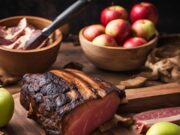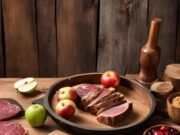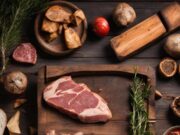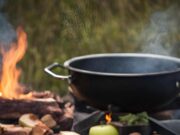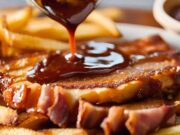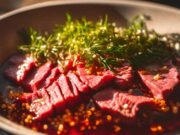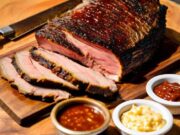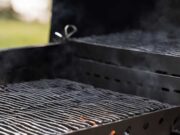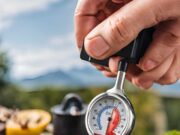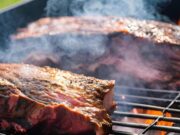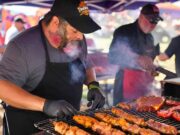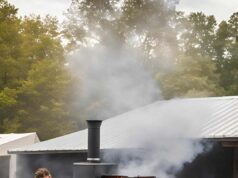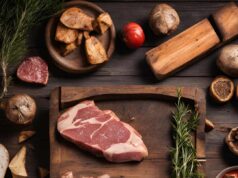Smoking meats is an art that allows you to extract rich flavors and textures, transforming ordinary cuts into mouthwatering dishes.
Understanding the nuances of smoking times and temperatures is crucial for achieving the ideal smokiness for various types of meat, including beef, pork, poultry, and seafood.
This guide offers essential charts and techniques to aid you in mastering the smoking process, enhancing flavors, and navigating the variables that can impact your results.
Whether you are an experienced pitmaster or a curious beginner, this information will provide you with the knowledge needed to create perfectly smoked meats every time.
Key Takeaways:
- Perfectly smoked meats require precise smoking times and temperatures, ensuring a delicious and safe end result.
- Choosing the right wood and using a meat thermometer are crucial techniques for enhancing flavor and achieving the perfect doneness.
- Environmental factors and type of smoker used can greatly influence smoking time, so it is important to monitor and adjust as needed.
Perfectly Smoked Meats: A Comprehensive Smoking Time and Temperature Chart
Smoking meat is a culinary technique that has been valued for centuries, with traditions firmly embedded in BBQ culture. This comprehensive smoking time and temperature chart offers essential insights for achieving perfectly smoked meats, whether you are preparing chicken, pork, turkey, beef, or specialty cuts such as brisket and ribs.
Understanding the balance of temperature and time is crucial to ensuring that your meats remain juicy and flavorful while developing that irresistible smoky aroma characteristic of traditional barbecue cooking. Regardless of whether you use hickory, apple wood, or cherry wood, mastering the art of smoking can significantly enhance your dining experience.
What is Smoking and Why It’s Preferred?
Smoking is a cooking process that involves exposing meat to smoke from burning or smoldering materials, typically wood, to infuse rich flavors and preserve the meat.
This ancient technique not only enhances the taste profile but also adds complexity and depth that other cooking methods may not achieve. The slow infusion of smoke allows the meat to absorb various compounds that develop during the burning process, resulting in a multifaceted flavor experience.
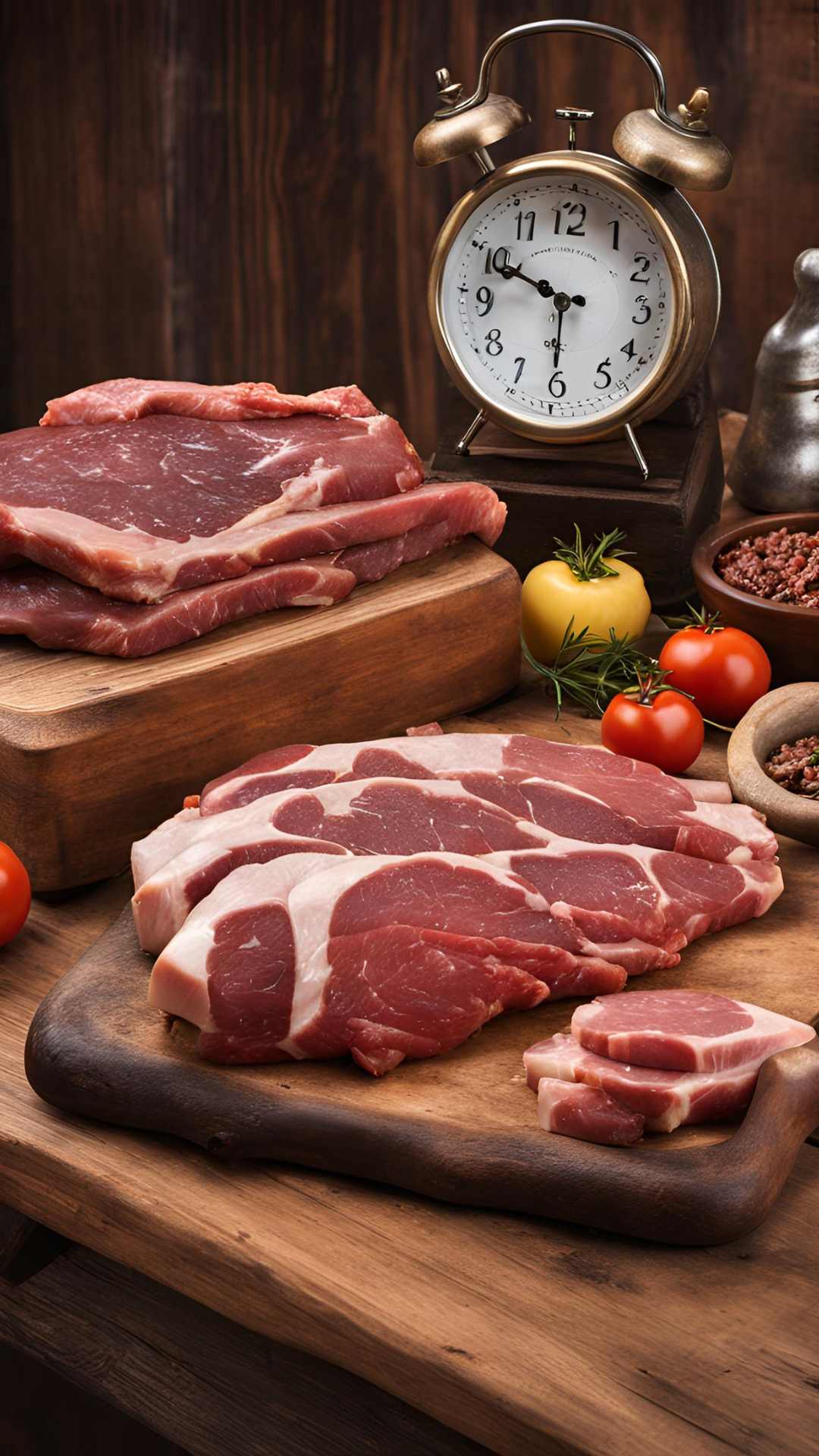
Tradition indicates that different woods, such as hickory, mesquite, and cherry, yield unique effects—hickory imparts a robust and earthy flavor, while cherry contributes a subtle sweetness. This flavorful practice has deep cultural roots in BBQ traditions, fostering community gatherings where families and friends come together to enjoy the smoky delights crafted through time-honored methods.
Understanding the Importance of Smoking Times and Temperatures
Understanding the importance of smoking times and temperatures is critical for achieving perfectly cooked and safe-to-eat meats, ensuring that each cut retains its juiciness and succulence.
Different types of meat, such as pork, beef, and poultry, require distinct treatment during the smoking process. For example, pork shoulder benefits from low temperatures over several hours to break down its connective tissues, while chicken may only need a few hours at higher heat to ensure it remains moist and flavorful.
It is essential to monitor these variables closely, as improper smoking can result in dry or undercooked meat. This is where a meat thermometer becomes an critical tool, allowing you to accurately gauge internal temperatures. This not only ensures perfect doneness but also guarantees food safety, as certain meats must reach specific temperatures to eliminate harmful bacteria.
By adhering to these principles, you can elevate your smoking skills and enjoy delicious, safe meals.
Smoking Temperatures for Different Types of Meat
Different types of meat require specific smoking temperatures to enhance their flavors and achieve the desired texture. Therefore, understanding these nuances is essential for any BBQ enthusiast aiming for optimal results.
Beef
When smoking beef, whether it’s brisket or ribs, achieving the right temperature is crucial to ensure that the meat remains tender and flavorful.
The ideal smoking temperatures can vary depending on the cut of beef. For brisket, a low and slow approach at around 225°F to 250°F often yields the best results, while ribs typically reach their peak at slightly higher temperatures within the same range.
Utilizing an internal meat thermometer is essential; it allows you to gauge doneness and ensure that safety standards are met, preventing potential health risks associated with undercooked beef.
To enhance flavor, consider marinating the meat or using dry rubs, which allow seasonings to penetrate deeply. Incorporating wood chips such as hickory or mesquite can impart a rich smokiness that elevates the overall taste experience.
Pork
Smoking pork requires a careful balance of temperature to ensure that the meat remains juicy and tender, which is essential for any BBQ enthusiast.
To achieve the best results, it is crucial to understand the smoking temperatures for different cuts. For instance, pork shoulders generally perform well when smoked at a lower temperature, around 225°F to 250°F. This gradual cooking process allows the connective tissues to break down effectively. In contrast, pork chops benefit from a slightly higher smoking temperature, ideally between 275°F and 300°F, to maintain moisture without the risk of drying out.
Regardless of the cut you are working with, utilizing a meat thermometer is highly recommended. This tool will help you ensure that the internal temperature reaches a safe level of 145°F for chops and 195°F for shoulders, thus enhancing both flavor and safety.
Poultry
When smoking poultry, such as chicken and turkey, it is essential for you to monitor the temperature closely to achieve moist and juicy results.
Achieving the ideal smoking times and temperatures for different cuts of poultry can significantly enhance the overall flavor and texture of the meat. For example, a whole chicken typically requires a smoking time of about 3 to 4 hours at a steady temperature of 225 to 250 degrees Fahrenheit, while smoking turkey breasts generally takes around 2 to 3 hours at similar temperatures.
It is crucial to ensure that the internal temperature reaches at least 165 degrees Fahrenheit for safe consumption. This not only guarantees a health-conscious meal but also locks in that rich, smoky flavor that everyone appreciates. Mastering these details can make all the difference in creating memorable dishes.
Lamb
Smoking lamb can significantly enhance the depth of flavor in your culinary creations, but it requires careful attention to temperature management.
The ideal smoking temperatures for lamb depend on the specific cut being used. For example, a leg of lamb is best smoked using a low and slow technique at around 225°F. This approach ensures the meat remains tender while it absorbs the rich, smoky essence. In contrast, racks of lamb can be smoked at slightly higher temperatures, ranging from 250°F to 275°F, which aids in developing a beautiful crust while keeping the interior succulent.
Utilizing this smoking method not only intensifies the natural flavors but also adds subtle hints of wood smoke that enhance the lamb’s inherent taste, resulting in a memorable meal that truly delights the senses.
Fish and Seafood
Smoking fish and seafood is an excellent method to infuse rich flavors while preserving the delicate texture of the meat through careful temperature management.
By meticulously controlling the smoking temperatures, you can enhance the natural taste of various types of fish, ranging from salmon to snapper. For example, fatty fish like salmon performs exceptionally well when smoked at temperatures between 175°F and 200°F. This range allows the oils to blend beautifully with the smoke, resulting in a succulent dish. Conversely, leaner options such as cod or tilapia benefit from slightly cooler temperatures of 160°F to 180°F, which helps maintain their tender structure while absorbing the aromatic essence of the smoke.
Whether you are preparing a casual family meal or hosting an upscale dinner party, expertly smoked seafood can elevate the dining experience, making each bite truly memorable.
Smoking Times for Various Meats
Each type of meat has its own specific smoking times that are critical for achieving the desired flavor and tenderness. Therefore, it is essential to consult a smoking chart to ensure optimal results.
Comprehensive Smoking Time Chart
A comprehensive smoking time chart provides clear guidelines for how long each type of meat should be smoked to achieve optimal results.
This chart serves as a valuable resource for both novice and experienced pitmasters, aiding them in navigating the complex world of smoking meats. By outlining specific times for various cuts, such as pork shoulder, brisket, chicken thighs, and turkey breast, it allows cooks to plan their smoking sessions with precision.
Several factors can influence these smoking durations, including the type of smoker used, temperature settings, and environmental elements such as humidity and wind. Understanding these variables can significantly enhance flavor and texture, ensuring that each meat preparation is not only delicious but also cooked to perfection.
Techniques for Perfectly Smoked Meats
Mastering the techniques for perfectly smoked meats not only enhances flavor but also ensures that the meat is cooked safely and retains its juicy texture.
By applying these proven methods, you can elevate your culinary skills while prioritizing food safety and quality in every dish.
How to Measure Temperature Accurately
Accurate temperature measurement is vital for safely smoking meat, and a reliable meat thermometer is an essential tool for any BBQ enthusiast.
Utilizing various types of meat thermometers, such as digital instant-read or probe thermometers, allows you to ensure that meats reach the recommended internal temperatures for both safety and optimal flavor. Measuring the internal temperature is crucial not only for eliminating harmful bacteria but also for ensuring that the meat remains juicy and flavorful.
During the smoking process, checking the temperature at different stages—such as halfway through cooking and just before the meat is expected to be done—provides valuable insights into how well the meat is cooking, enabling you to achieve better timing and preparation for a perfect meal.
Tips for Enhancing Flavor
Enhancing the flavor of smoked meats requires careful consideration of seasoning, wood selection, and cooking techniques that develop rich aromas.
To elevate the taste, you should consider using a variety of seasoning blends, such as a mixture of smoked paprika, garlic powder, and brown sugar, which can introduce a delightful complexity to the meat. The choice of wood is also crucial; different types, like hickory, impart a strong, bold flavor, while fruit woods such as apple or cherry add a subtle sweetness. Techniques like brining the meat beforehand or using a dry rub can infuse essential flavors right from the start.
By experimenting with these elements, you can unlock a world of taste, ensuring that the final dish is both savory and satisfying.
Choosing the Right Wood
Choosing the right wood for smoking is essential, as different types impart unique flavors that can significantly influence the final taste of the meat.
For example, hickory wood is known for its strong, hearty flavor, making it an excellent choice for red meats like brisket and pork. On the other hand, apple wood provides a subtler, sweeter taste that pairs wonderfully with poultry and fish, enhancing their natural flavors without overwhelming them. Cherry wood, with its rich, fruity undertones, adds a beautiful color to the meat while complementing various cuts effectively.
When selecting wood, it is important to consider both the type of meat and the desired flavor profile. Milder woods like birch work well with delicate proteins, while bolder options like mesquite can stand up to more robust meats. Always remember to use dry, seasoned wood for optimal results in your smoking process.
Proper Seasoning Techniques
Proper seasoning techniques are essential for enhancing the flavor of smoked meats and can be effectively achieved through the use of rubs, marinades, and brines.
These methods not only amplify the meat’s natural flavors but also tenderize it, making each bite more enjoyable. Dry rubs consist of a blend of spices, herbs, and sometimes sugars, forming a flavorful crust that locks in moisture during the smoking process.
In contrast, marinades involve soaking the meat in a seasoned liquid that infuses it with rich flavors, often incorporating acidic elements like vinegar or citrus to help break down proteins. Brining, a time-honored technique, involves soaking the meat in a saltwater solution, ensuring it remains juicy and flavorful even after prolonged cooking.
Each of these methods can be customized to suit specific types of meat, encouraging unique flavor profiles that are sure to delight the palate.
Using a Meat Thermometer
Using a meat thermometer is a crucial step in the smoking process, ensuring that your meats are cooked to the appropriate temperature for both safety and optimal taste.
There are several types of meat thermometers available, including instant-read, probe, and wireless models, each tailored to specific cooking needs. Instant-read thermometers allow for quick temperature checks during the smoking process, while probe thermometers can remain in the meat throughout smoking to monitor temperature changes in real-time. Wireless options provide added convenience, enabling you to track the progress from a distance.
Effectively using these tools is essential; inserting the thermometer into the thickest part of the meat without touching bone will ensure you obtain accurate readings. Understanding the significance of the correct internal temperatures not only guarantees food safety, preventing foodborne illnesses, but also enhances flavor and tenderness, resulting in perfectly smoked meats every time.
Factors Influencing Smoking Time
Several factors influence the smoking time of meats, including environmental conditions and the type of smoker utilized. It is essential for BBQ enthusiasts to take these variables into account to achieve optimal results.
Environmental Factors
Environmental factors such as weather and humidity can significantly influence the smoking time of meats, requiring you to make necessary adjustments for optimal results.
When temperatures drop or humidity levels rise, meats may require additional time to achieve the desired tenderness and flavor infusion. For instance, on a chilly day, monitoring the internal temperature of the meat becomes crucial, as it may take an hour or more longer compared to a warmer day. Conversely, high humidity can introduce excess moisture, which can affect smoke absorption and overall cooking efficiency.
To address these variables, experienced cooks often recommend preheating the smoker slightly more than usual in cold weather or extending cooking times when humidity is high. Keeping a reliable thermometer on hand will help ensure that your meats are cooked to perfection, no matter the conditions.
Type of Smoker Used
The type of smoker you choose can significantly influence both the smoking time and flavor of the meat, with various options available, each offering distinct benefits.
Charcoal smokers are known for imparting a deep, rich flavor that many enthusiasts highly value. However, they require more attention and skill to effectively manage temperature control.
In contrast, electric smokers offer a more hands-off experience, allowing you to set the desired temperature and let the machine handle the rest, though this convenience may come at the cost of an authentic smoky taste.
Wood smokers are particularly celebrated for their ability to create complex flavor profiles, which can vary significantly depending on the type of wood used, such as hickory or mesquite. This variability also contributes to diverse smoking times due to their fluctuating heat output.
Each type of smoker, therefore, presents its own set of advantages and challenges, ultimately impacting not only the cooking process but also the enjoyment of the final product.
Final Thoughts on Perfectly Smoked Meats
Perfectly smoked meats not only tantalize your taste buds but also create memorable dining experiences that honor the rich tradition of BBQ culture.
The satisfaction you derive from mastering the art of smoking extends beyond the exquisite flavors; it cultivates a sense of pride and accomplishment. As you experiment with various woods, rubs, and techniques, you uncover new dimensions of culinary creativity. Sharing these lovingly prepared dishes with family and friends amplifies the joy, transforming meals into occasions filled with laughter, storytelling, and connection.
Each gathering becomes a testament to your skill and hospitality, while the continuous pursuit of improvement serves as a reminder that there is always something new to learn in this age-old craft.
Recommended Resources for Further Reading
For those seeking to enhance their knowledge of smoking techniques and BBQ, a wealth of resources is available, offering valuable insights, recipes, and expert tips.
Aspiring BBQ enthusiasts can explore a variety of books, such as “The Barbecue Bible” by Steven Raichlen, which is well-regarded for its comprehensive approach to grilling and smoking. Websites like AmazingRibs.com provide detailed guides and advice from aficionados, helping you understand different cuts of meat and optimal wood pairings.
Participating in local BBQ competitions can also be beneficial, as they often welcome newcomers and provide hands-on experiences. Additionally, joining forums and Facebook groups dedicated to BBQ can prove to be incredibly advantageous, allowing you to share experiences, troubleshoot issues, and exchange creative ideas for enhancing flavor.
Frequently Asked Questions
What is the purpose of a smoking time and temperature chart for perfectly smoked meats?
A smoking time and temperature chart helps guide the cooking process by providing recommended temperature settings and estimated cooking times for various types of meats, ensuring that they are cooked thoroughly and to perfection.
How can I use a smoking time and temperature chart to achieve the perfect level of doneness for my meats?
By following the recommended temperature and cooking times on the chart, you can cook your meats to your desired level of doneness, whether it’s rare, medium, or well done. This ensures that your meats are cooked to perfection and safe to eat.
Are there different smoking time and temperature charts for different types of meats?
Yes, there are different smoking time and temperature charts for different types of meats, as each type of meat has its own ideal cooking temperature and time. It is important to use the specific chart for the type of meat you are cooking to ensure the best results.
Can I adjust the smoking time and temperature for my personal taste preferences?
Yes, you can adjust the smoking time and temperature to your personal preference. However, it is important to note that changing the recommended cooking settings may affect the doneness and safety of the meat.
What factors should I consider when using a smoking time and temperature chart?
When using a smoking time and temperature chart, it is important to consider the thickness and weight of the meat, as well as the type of smoker being used. Thicker and heavier meats may require longer cooking times, and different types of smokers may have varying temperature settings.
How often should I refer to a smoking time and temperature chart while smoking meats?
It is recommended to refer to a smoking time and temperature chart periodically throughout the cooking process to ensure that the meat is cooking at the correct temperature and for the appropriate amount of time. This will help prevent overcooking or undercooking the meat.



